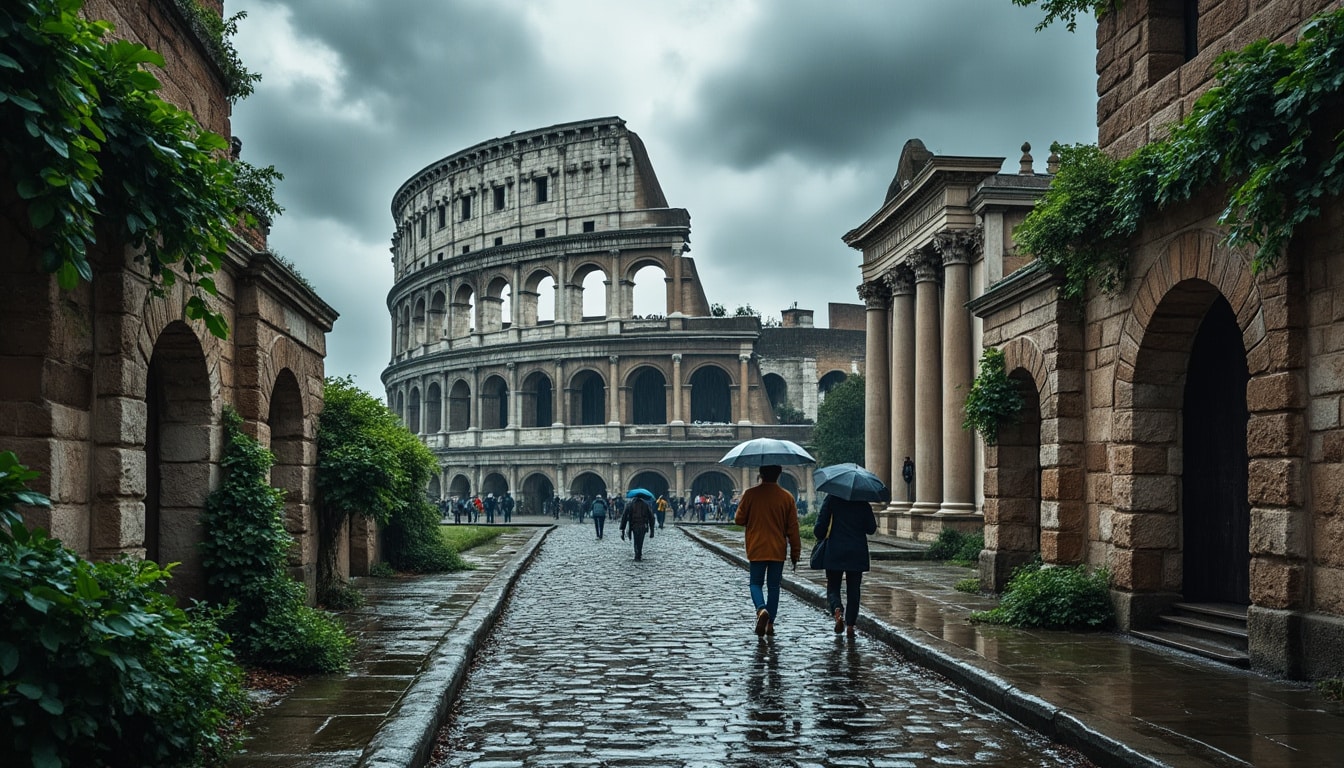Rome, the Eternal City, is famous for its rich history, delicious cuisine, and enchanting beauty. However, visitors and residents alike often experience another permanent feature: the city’s unique humidity. Understanding Rome’s humidity levels and how they affect life there is crucial for both tourists planning their visits and locals managing their daily routines. This article delves into Rome’s atmospheric conditions, providing practical insights on managing and enjoying the city’s climatic charms.
Understanding the Seasonal Changes in Rome’s Humidity
Rome’s humid climate varies throughout the year, influenced by its Mediterranean characteristics. High humidity levels can impact one’s experience, making the city feel warmer or cooler than the actual temperature. In November, the humidity usually peaks at around 77%, while the lowest levels, about 72%, occur in July. These fluctuations significantly affect how comfortable it is to engage in outdoor activities or simply stroll through historic neighborhoods.

Winter months, from December to February, bring more moisture, with frequent rains that enhance the humidity. While temperatures range from a minimum of 3.5°C (38.3°F) in January to a maximum of 12.1°C (53.8°F) in February, the city is often enveloped in a misty veil that adds a romantic allure to its ancient streets. To enjoy the best of winter in Rome, visiting indoor attractions like museums and historical buildings can be ideal, given that outdoor explorations might be a bit damp.
In contrast, spring and fall offer more temperate conditions. Spring sees a gradual warming, with humidity hovering around 74%, making it perfect for enjoying the blooming landscapes and participating in cultural festivities. By fall, the city cools down from the summer’s heat, and the slight increase in rainfall offers a refreshing break. October and November, despite being wetter months, provide the perfect backdrop for indulging in Rome’s indoor and outdoor activities due to their vibrant atmospheres and cultural events.
Understanding these seasonal differences is vital for planning visits to Rome. Whether you’re a visitor planning a trip or a local planning daily activities, being aware of these climate quirks helps in choosing the right time for different outdoor adventures. Investing in gadgets like humidity sensors and climate control systems can also aid in managing comfort levels indoors.
The Impact of Humidity on Comfort and Daily Life in Rome
The constant interplay between temperature and humidity in Rome creates distinct challenges and opportunities for enhancing personal comfort. High humidity, especially during the warmer months, augments the feeling of heat, making it crucial to take precautions for maintaining personal well-being and comfort.
In the hot summer months of June, July, and August, the temperatures can soar to a high of 30.5°C (86.9°F). Combined with the humidity, these conditions can be stifling, particularly for those not used to such climates. For residents and travelers, adapting their lifestyles is key. Simple practices like wearing lightweight clothing, taking frequent breaks in shaded areas, and consuming plenty of water become essential. Utilizing air conditioning units and air purifiers can significantly improve indoor air quality, making these months more bearable.
The contrast is evident during the cooler winter months, when high humidity can make the cold air feel more biting. During this time, heavily layered clothing and warm, moisture-wicking fabrics are practical choices. The adoption of dehumidifiers and smart thermostats can help to regulate indoor temperatures and humidity, ensuring a comfortable living or visiting experience.
Aside from personal comfort, humidity can also impact architectural integrity. Historic buildings and ancient ruins are particularly susceptible. High humidity levels can lead to mold growth, which is a significant concern for preservation. Therefore, various mold prevention products are employed to mitigate these effects, safeguarding against damage that could otherwise compromise these treasured sites.
For those working or living in Rome, recognizing these humidity dynamics and using tools like humidity control devices ensures a balanced, healthy environment. This consideration extends to using HVAC systems that can efficiently handle the climate’s demands. Adaptability and foresight in addressing these weather challenges translate into a more enjoyable experience, regardless of the season.
Monthly Weather Patterns and Their Implications in Rome
To fully appreciate Rome’s humidity levels, it’s insightful to examine its monthly weather patterns. Each month brings its own set of climatic characteristics, making the understanding of these patterns advantageous for a variety of activities, from tourism to daily living.
| Month | Avg. Temperature (°C) | Humidity (%) | Rainfall (mm) | Rainy Days |
|---|---|---|---|---|
| January | 7.2 | 79% | 67 | 7 |
| February | 7.8 | 76% | 75 | 7 |
| March | 10.6 | 75% | 77 | 7 |
| April | 13.8 | 74% | 83 | 8 |
| May | 17.9 | 71% | 60 | 6 |
This table offers a snapshot of how Rome’s temperatures, humidity, and rainfall vary month by month. The distinct differences between months showcase the Mediterranean climate’s adaptability and highlight the importance of planning in accordance with these variables.
From March to May, rainfall decreases and temperatures become more comfortable, making these months particularly appealing for tourists. Spring in Rome is a time when the natural landscapes, such as the famous gardens of Villa Borghese, display their vibrant colors, inviting leisurely walks and picnics.
Practical Tips for Managing Humidity in Rome
Experiencing Rome’s humidity requires some preparation and savvy tips. Here are a few practical suggestions to ensure an enjoyable visit, regardless of the season:
- 🌞 Stay Hydrated: Ensure adequate water intake, especially during warmer months to prevent dehydration.
- 🧥 Dress Appropriately: Light, breathable fabrics in summer and layered, moisture-wicking clothes in winter help in managing comfort.
- 🏠 Use Climate Control Devices: Invest in dehumidifiers and air purifiers to improve indoor air quality.
- 🏢 Choose Lodging Wisely: Consider accommodations with reliable air conditioning and humidity control systems.
- 👟 Pace Your Activities: Plan daily activities that allow rests during peak heat or rain times.
Applying these tips not only ensures comfort but also enhances the overall experience, allowing you to enjoy Rome’s offerings without succumbing to the effects of humidity.
Humidity’s Influence on Transportation and Tourism in Rome
Humidity significantly impacts transportation and tourism in Rome, two sectors integral to the city’s economy. During summer, when tourists flock to the city, the increased humidity can make public transport crowded and noticeably warmer. Efficient use of climate-controlled transport systems like modern subways and buses becomes essential during this time, ensuring passenger comfort.
Tourism thrives when visitors are comfortable and engaged. As humidity swells, Rome’s walking tours can become exhaustive, making it essential to schedule breaks in shaded or air-conditioned environments. Many historic sites and museums now incorporate improved climate management technologies, such as advanced HVAC systems and smart thermostats, to create more pleasant conditions indoors.
The Rome Ciampino and Fiumicino airports also play crucial roles in maintaining passenger comfort. Both airports are equipped with climate control systems to manage indoor air quality as travelers arrive or depart, ensuring a smooth start or end to their journey in Italy’s capital.
Tour operators also adapt itineraries to account for humidity, offering morning or evening tours to escape peak heat and humidity. These strategic adjustments not only enhance the tourist experience but also support operators in providing memorable engagements amid Rome’s historic settings.
Frequently Asked Questions (FAQ)
- Q: What is the best time of year to visit Rome regarding humidity?
A: Spring (April-May) and early fall (September-October) have moderate humidity levels, making them ideal for visiting.
- Q: How does humidity affect sightseeing in Rome?
A: High humidity can intensify the heat in summer and chill in winter, affecting comfort during outdoor activities. Preparing with appropriate clothing and hydration is key.
- Q: Are accommodations equipped to handle Rome’s humidity?
A: Most hotels and apartments in Rome provide air conditioning and heating systems designed to manage humidity for guest comfort.

